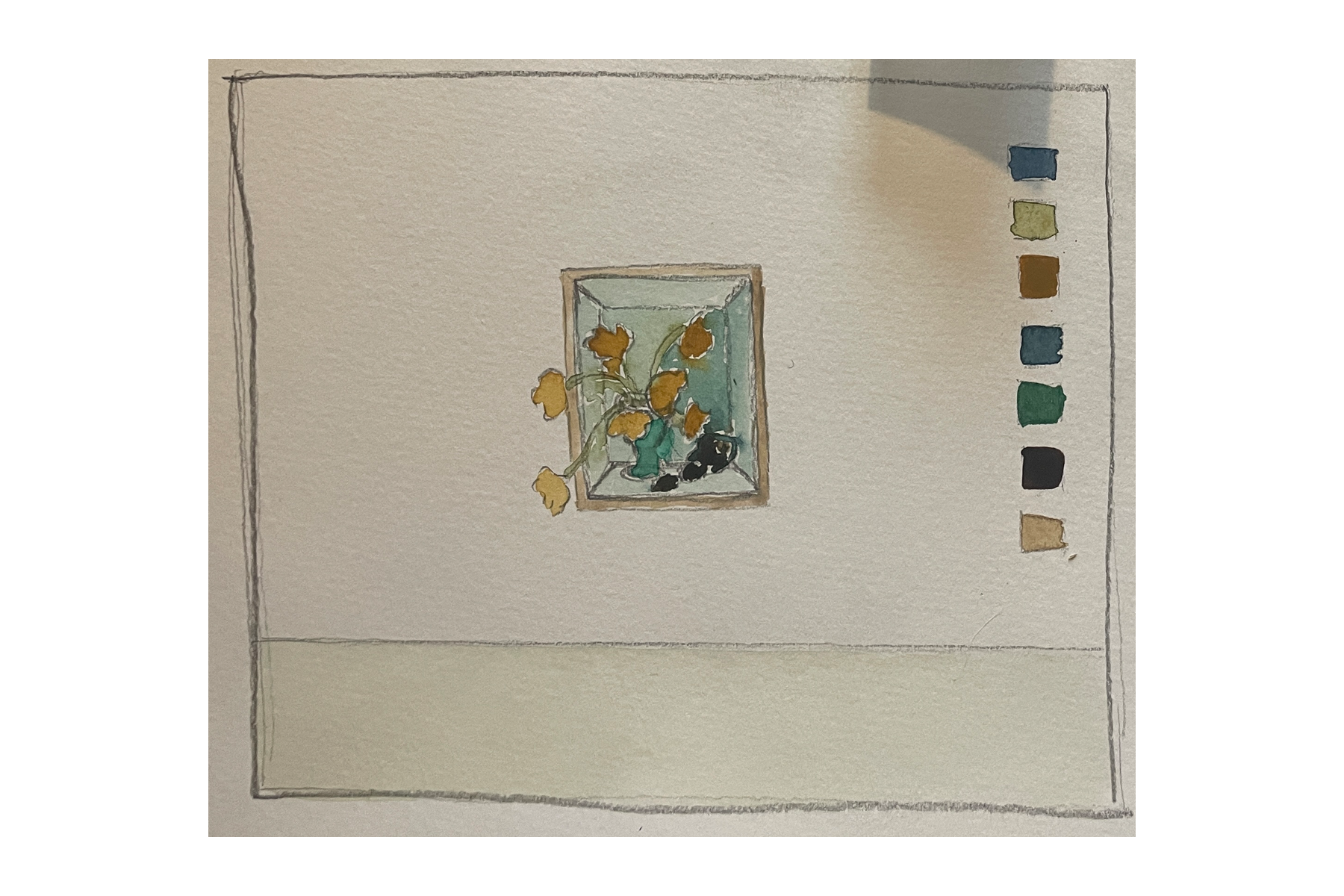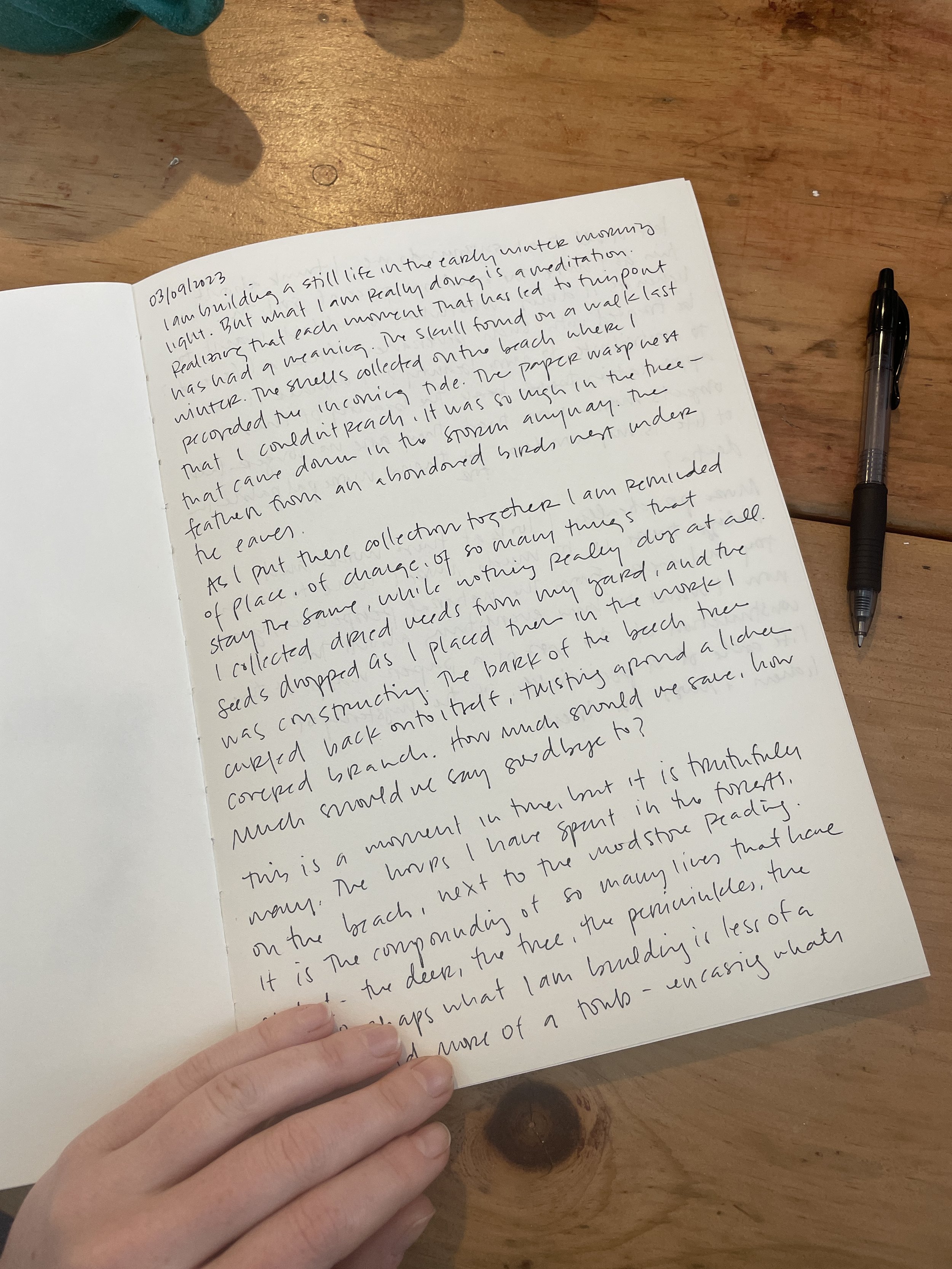23 February 2023
I have been thinking a lot about the “bookends” lately — the beginning and the end, the start and the finish. What we, as a society, tend to celebrate. The seen aspects of lives tend to be the momentous ones: those marked by a beginning, an end. The in-between seems to be what we often choose not to acknowledge, yet as I am reminded constantly by a small post-it note on the edge of my computer screen: Your life is always happening in just a single moment.
Perhaps that is what I am most interested in as we start this project — the process itself. The slow rituals of creating the work: thinking, seeing, reading, making. And in a way, process is so integral to the display of this work in what I’m currently envisioning as its “end” that I cannot divorce the two. For me, there is the process of creating the objects for display — of placing each stem, each object. Creating movement through stillness and small moments in time that aren’t actually captured or ever the same. (I haven’t reread Barthes in a very long time, but I think the idea behind these sculptural works is akin to his view of the photograph: that it attests to our mortality.)
Beyond the process of creation is the process of decay — that which is on display, but is also only consumed in a single moment. Art that is simultaneously a finished object, a remnant of the past, and a changing —scape (landscape, tablescape? I am not entirely sure of the best way to describe these yet) that can only be experienced by the viewer in a single moment.
There is a vase of early season tulips on my desk. I have been observing them for the past week as their stems stretch toward the sunlight of the open window, as their petals have opened and reflexed back. Until yesterday, when they simply began to drop. Still holding their shape, they are cupped like oyster shells and make a small, soft sound when they fall. They began to pile up under the vase, reminding me of Félix González-Torres. What would it be like to fill a room with flower petals?
— EE




23 February, 2023
The sound-image of tulip petals dropping to the desk is highly evocative.
I wonder, though, whether this sound-image is more evocative when I read about it and imagine it (as I have done just now), or if I were to hear it recorded and reproduced through a speaker? Somehow, I suspect that this sound is most evocatively captured through a medium other than the microphone and that, if I were to hear it reproduced but divorced from its original context, it might underwhelm me. A mundane, barely-audible “plop.”
Is there value in a sound removed from its physical context?
Is the medium of perception always the most evocative medium of reproduction?
—SO
09 March, 2023
I am building a still life in the early winter morning light. But what I am really doing is a meditation. Realizing that each moment that has led to this point has had a meaning. The skull found in the forest on a walk last winter. The shells collected on the beach where I recorded the incoming tide. The paper wasp nest that I couldn’t reach, it was too high in the tree. It came down in the storm a few weeks after I discovered it, and I collected the pieces. The feather from an abandoned bird nest under the eaves.
As I put these collections together, I am reminded of place, of change. That so many things stay the same, even though nothing really does, does it? I collected dried weeds from my yard, and the seeds drop as I place them in the work I am constructing. The bark of the beech tree curls back onto itself, twisting around a lichen-covered branch. In someone else’s eyes, these are all disposable, destroyable. How much should we save? To how much should I say goodbye?





This is a moment in time, but truthfully, it is many. The hours I have spent in the forest, on the beach, next to the wood stove warmed by the burning of a past forest. It is the compounding of so many lives that have ended: the deer, the tree, the periwinkles, the wasps. Perhaps what I am building is less of a still life and more of a tomb — encasing what’s left of all the surrounds me. I think about this as I move the smallest piece of soil, nudge the lichen as it dries. Who — what — wouldn’t want to treated with such reverence after a life ends? To contribute to more beauty? I wonder if I am appreciating the beauty of these objects more now that they are no longer full of life. Is my wonder for them more palpable in their death?
More practically, I look at this work and realize there is so much more I have to learn. From the natural perspective, yes — now I want to know everything about the construction of the nest of paper wasp. Of the life cycle of a periwinkle. Of the mystery of lichen and moss on trees. The reasons we, as human, are so bent on the destruction of the fragile ecosystems in which we exist.
And then there is the craft — the building of frames, boxes. Of making them exactly the way they appear in my head. The issues of transport, the logistics of creating these small worlds and making sure that they can change while also allowing nothing to move. Backgrounds and color studies and seasonality and locality. I am realizing more and more that everything touches everything else.
— EE
09 March, 2023
My goal is to choose a single sound that is the perfect match for the field recording you’ve created. My intuition is that this will come from the organ.
27 July, 2023
Further research questions:
Do the waves sound different at low tide than they do at high tide? If so, would it be interesting or beautiful to juxtapose these two sounds? This isn’t something anyone can ever do in real life / real time.
Is there significant sonic variation from one coastal location to the next?
How loud (in real decibel terms) is the ocean when you’re standing next to it? There are free iPhone apps to measure decibel levels. We could calibrate our work so that the volume of the field recordings is hyper-realistic.


